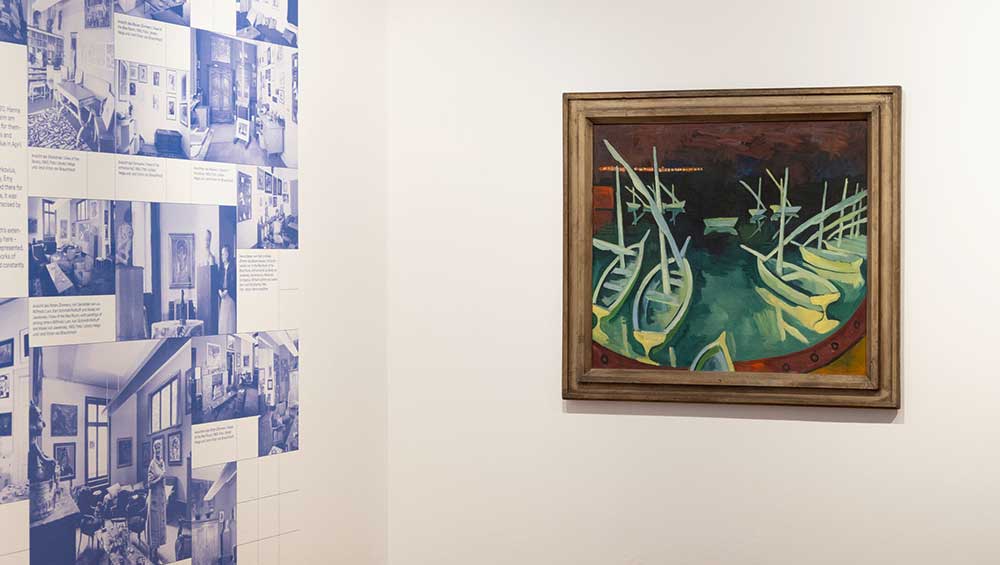
Exhibition view, Hanna Bekker vom Rath. A Rebel for Modern Art, Brücke-Museum, 2024. Photo: Alina Schmuch.
Brücke-Museum, Berlin
24 February – 16 June 2024
by SABINE SCHERECK
Hanna Bekker vom Rath was a beacon in the art world, tirelessly and courageously promoting modern and contemporary German art. At 59, she was organising visas and setting off to far-flung places, including São Paulo, Buenos Aires and Montevideo. All this in 1952, when such destinations were considered exotic, would have involved astronomical flight costs, and would have been visited mainly businessmen. But the German art collector, art dealer and painter was not deterred. Her aim was to show German art around the globe to rebuild relationships with numerous countries after the second world war had severed them.
The exhibition at the Brücke-Museum in Berlin is now shining a spotlight on this exceptional woman. Her affiliation with the museum lies within her deep friendship with Karl Schmidt-Rottluff, a member of the artists’ group Brücke, who laid the foundation for the museum when he donated his art collection to the city of Berlin in 1964. The curators, Lisa Marei Schmidt, director of the Brücke-Museum, and Marian Stein-Steinfeld, art historian and granddaughter of Bekker vom Rath, arranged the show chronologically, unfolding her achievements over the course of her life.
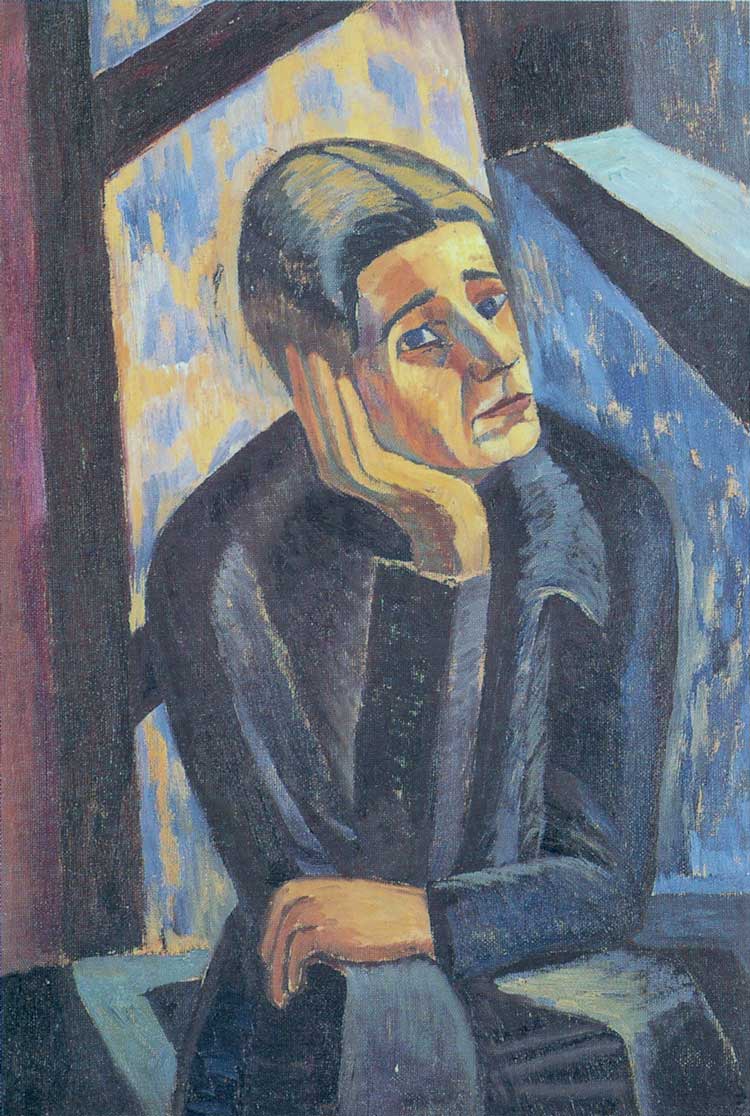
Hanna Bekker, Self (Mourning), 1944. Oil on canvas. Stadtmuseum Hofheim am Taunus, long-term loan from the archive of the Estate Hanna Bekker vom Rath. Photo: Herbert Fischer, Frankfurt am Main.
When entering the exhibition, a first impression of Bekker vom Rath is summoned through her biography and several portraits. Their differing painting styles hint at the many artists with whom she was friends. Born into an upper-middle-class family in Frankfurt in 1893 as Hanna vom Rath, she never conformed to the conventions of her class and followed her own convictions. Her love for art led to drawing lessons with the portrait artist Ottilie W Roederstein. Roederstein, who lived openly as a couple with Elisabeth Winterhalter, one of Germany’s first female doctors, in the small town of Hofheim in the Taunus region, had a great impact on Vom Rath. Her mentor became a lifelong friend, as did the more progressive artist Ida Kerkovius, with whom Vom Rath continued her art training. When Vom Rath married in 1920, her husband, the music critic, conductor and artistic director Paul Bekker, enabled her to continue her free-spirited approach to life, but his appointments at different venues and her role as a mother were restricting. She kept up her involvement in the art scene by collecting art and through her circle of artist friends.
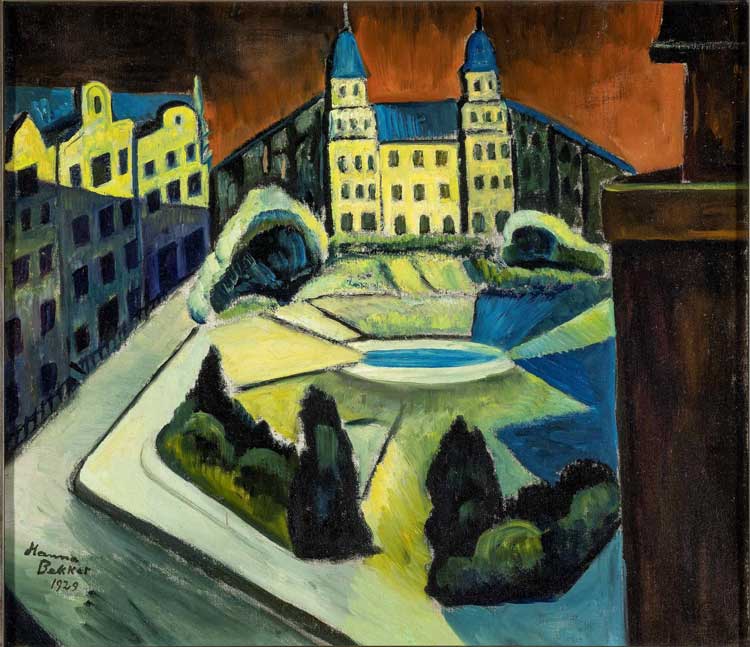
Hanna Bekker vom Rath, Berlin, Viktoria Luise Platz, 1929, Oil on canvas, Museum Wiesbaden. Photo: Museum Wiesbaden / Bernd Fickert.
Some artists are introduced here through their works, among them Ernst Wilhelm Nay with his modernist River Landscape (Brittany) (1942). The expressionist painter Alexej von Jawlensky, to whom she gave a great deal of support, was also a close friend. A more interesting chapter of her life is highlighted on the wall opposite. It includes a painting she did of a grand building with a little park in front and a dark red sky: Berlin, Viktoria Luise Platz (1929). The expressionist painting is rather gloomy and seems to anticipate the war. She separated from her husband in 1930 and went her own way. In addition to her home in Hofheim, called the Blue House, she frequently rented an apartment in Berlin. During the war in the early 1940s, when the oppressive cultural politics of the Nazi regime had banned the works of her artist friends, resulting in a loss of their income, she courageously organised clandestine exhibitions in her apartment. Participating artists included Willi Baumeister, Erich Heckel, Von Jawlensky, Kerkovius, Nay and Schmidt-Rottluff. She was successful in two ways: some artists did sell paintings at these shows and her undercover operation was never detected by the Nazis. Testament to that time is a guest book on display, which in itself was a risky thing to keep, as it could have fallen into the wrong hands.
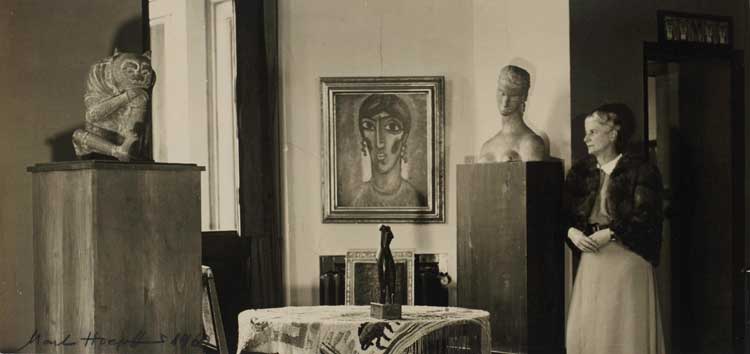
Hanna Bekker vom Rath with artworks by Alexej von Jawlensky, Ida Kerkovius, Alexander Archi-penko, Wilhelm Lehmbruck, as well as the river spirit Wuzhiqi (China, c960-1127 AD), 1946. Photo: Marta Hoepffner. © Estate Marta Hoepffner.
Following the wartime section, the colour palette changes radically: bright, vivid, fresh greens, yellow and orange envision landscapes, to be precise the garden of the Blue House as seen by Schmidt-Rottluff. The pair had been friends since the 1930s and he was a frequent guest at her house, so much so that Bekker vom Rath provided him with a small house and a studio on her estate. The paintings emanate a joy that makes the visitor linger and soak up the uplifting energy. One is Hot Park in the Taunus (1950) with vibrant and dark green trees and an orange fountain. Another is Veranda with Parasol (1958), which captures the balcony outside the studio of the Blue House. The parasol is a striking yellow and the chestnut tree behind is in blossom. It is a very inviting scene: there is a bench (or a table?) on which one could sit and delight in the scenery. In this context, the pictures here also represent the enormous generosity that Bekker vom Rath showed towards her friends to enable them to pursue their art.
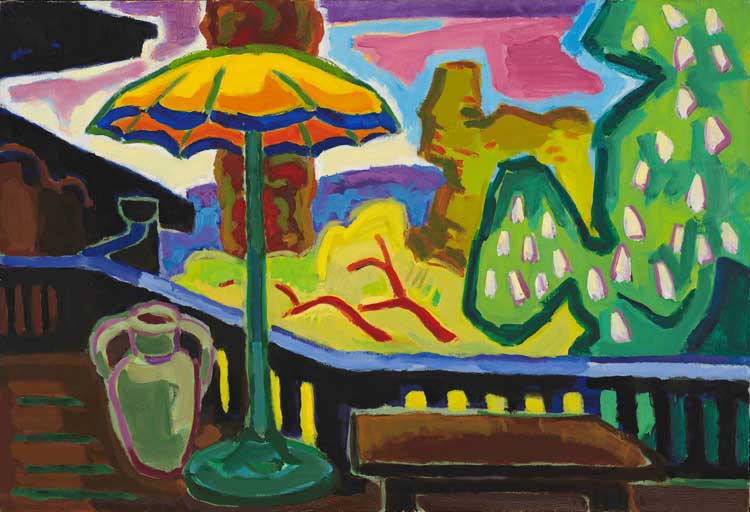
Karl Schmidt-Rottluff, Veranda with Parasol, 1958. Oil on canvas. Brücke-Museum, Karl und Emy Schmidt-Rottluff Stiftung. © VG Bild-Kunst, Bonn.
After the war, in 1947, Bekker vom Rath was quick to get artists some exposure again and remind the public of the power of art by opening a gallery of her own, Frankfurter Kunstkabinett Hanna Bekker vom Rath. Käthe Kollwitz’s charcoal drawing Study for Performance (1915) shown here from Vom Rath’s own collection stands for the high-profile artists who were presented in her gallery. Alongside her long-term friends Jawlensky and Schmidt-Rottluff, she showcased artists whose names are less well known today, such as HAP Grieshaber and Kurt Federlin who belonged to a younger generation. These abstract, expressionistic and avant-garde works demonstrate that she was passionate about the art of her time. One wall is dedicated solely to the large variety of works that comprised her collection. Among them is a small, charming collage, which stands out because of the simplicity and clarity of its shapes and colour. Afternoon/Interior (1959) by Siegfried Shalom Sebba shows a room with sunlight coming through the window and something that looks like a table or a piano, on which is a tiny snippet of paper with Hebrew letters. It evokes peace, but also suggests survival or perhaps a memory of bygone days. There is also Heckel’s watercolour Water Lilies (1945), which catches the eye.
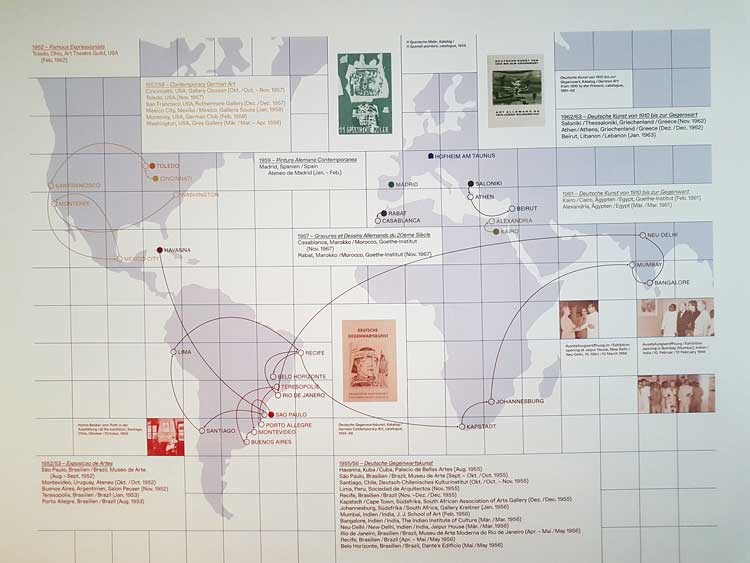
The map showing Hanna Bekker vom Rath's travels. Exhibition Design: Pool Practice. Photo: Sabine Schereck.
Moving on to the 1950s, the visitor reaches the section covering the time during which Bekker vom Rath acted as a worldwide ambassador for modern German art. A wall-sized map traces her journeys between 1952 and 1967 to great effect as it deepens the sense of what a driving force she was and how strongly committed she was to mediating art. During these years, she organised eight exhibition tours, which took her to 30 cities across five continents. Often, she would travel for months. Always tagging along was her aluminium suitcase filled with works on paper, which were easier to transport than oil paintings.
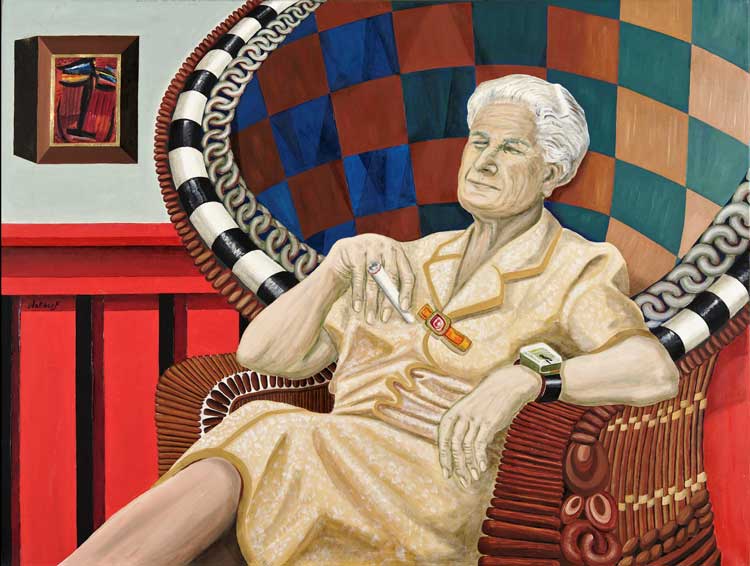
Benno Walldorf, Hanna Bekker vom Rath, 1968. Oil on canvas, Museum Wiesbaden. Photo: Museum Wiesbaden / Bernd Fickert. © VG Bild-Kunst, Bonn.
For the exhibition German Contemporary Art in 1955/56, for example, she packed more than 230 works by 88 artists, mainly acclaimed expressionists such as Franz Marc and many members of Brücke. Once at her destination, she would source passe-partouts locally and spend hours cutting them to present the artwork adequately. The works came from her collections or from artists who she represented in her gallery. There was also the occasional loan from a public institution. Abroad, she not only made the odd sale but also acquired art herself to showcase in Germany and nurture the artistic exchange between the countries and cultures. Only a few tours were supported financially by the German state and, even then, the money was granted on condition that she did not sell any work as the government did not want to support private commercial undertakings. To give a better insight into these ventures, the final section in the exhibition focuses on one particular tour: German Art from 1910 to the Present. This exhibition toured to Greece and Lebanon in 1962 to 1963 and was commissioned by the Cultural Department of the Federal Foreign Office. This enabled Bekker vom Rath to include loans from German museums. The catalogue reveals that she had brought works from her private collection, too, including Lyonel Feininger’s City Gate (1923) and Paul Klee’s Runner – Hooker – Boxer (1920), which are also on display here.
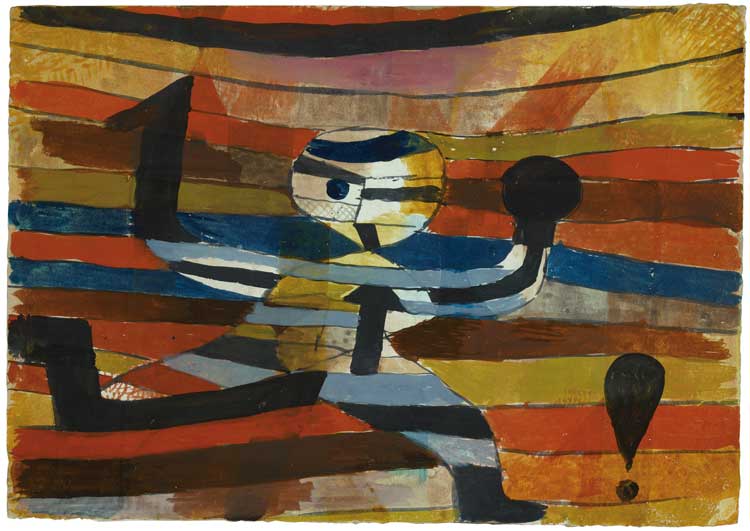
Paul Klee, Runner – Hooker – Boxer, 1920. Watercolour on paper. Museum Wiesbaden, long-term loan from the Archive of the Estate Hanna Bekker vom Rath. Photo: Fotostudio Herbert Fischer, Frankfurt.
The Brücke-Museum has created a comprehensive and varied show with more than 100 pieces, including paintings, works on papers, sculptures and textile works – not counting the numerous photographs accompanying the wall texts. They chart her life, showing her laughing with friends, at home at her Blue House, posing with treasures from her collection, or at work running her art gallery and later presenting her exhibitions worldwide. The visitor gets a good sense of an active and happy woman, who was passionate about her work within the arts.
It is a great achievement that the Brücke-Museum has not followed the trend of recent years that blows off the dust of another forgotten female artist. Instead, the museum looks deeper into the art world and brings to light a woman who was influential behind the scenes. The same applies to the Liebermann Villa am Wannsee, which last year dedicated an exhibition to the art dealer, art collector and art historian Grete Ring (1887–1952). Ring worked for the renowned art dealer Paul Cassirer in Weimar Berlin and, after his death in 1926, she took over the enterprise together with Walter Feilchenfeldt. When the Nazis came to power, the company had to be restructured and she relocated to London setting up a new gallery under his name.
In both cases, it is refreshing to see such self-determined, emancipated and inspirational women brought to life, particularly as they asserted themselves within the male-dominated business side of the arts at a time when women were hardly taken seriously in any professional domain. Their work required very different skills than those of their female counterparts who mixed colours and captured landscapes and portraits.